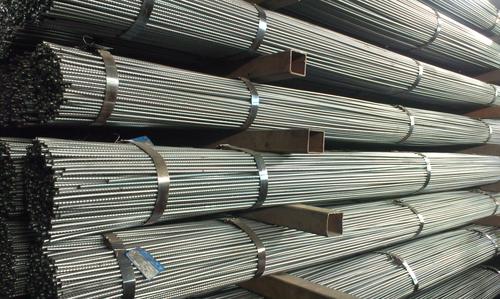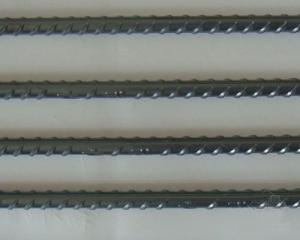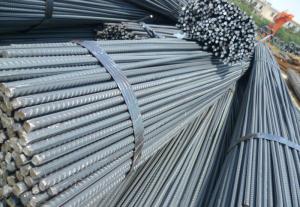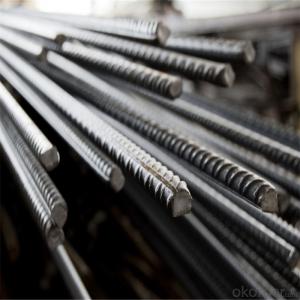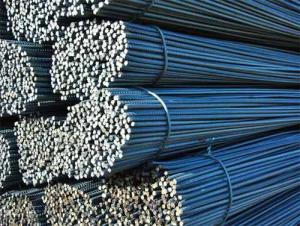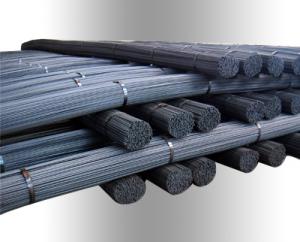Cold Rolled Rebar 16mm
- Loading Port:
- China Main Port
- Payment Terms:
- TT OR LC
- Min Order Qty:
- -
- Supply Capability:
- -
OKorder Service Pledge
Quality Product, Order Online Tracking, Timely Delivery
OKorder Financial Service
Credit Rating, Credit Services, Credit Purchasing
You Might Also Like
Cold Rolled Techniques
Yield Point: 545-565mpa
Deformed bar is widely used in buildings, bridges, roads and other engineering construction. Big to highways, railways, bridges, culverts, tunnels, public facilities such as flood control, dam, small to housing construction, beam, column, wall and the foundation of the plate, deformed bar is an integral structure material. With the development of world economy and the vigorous development of infrastructure construction, real estate, the demand for deformed bar will be larger and larger.
- Q: Can steel rebars be used in tunnels and underground structures?
- Yes, steel rebars can be used in tunnels and underground structures. Rebars are commonly used in construction projects to reinforce concrete structures and provide additional strength and durability. In tunnels and underground structures, where stability and load-bearing capacity are crucial, steel rebars are often incorporated into the concrete walls, floors, and ceilings to enhance their structural integrity. The rebars help to distribute the load and resist potential cracks or deformations caused by the pressure from the surrounding soil or water. Moreover, steel rebars offer resistance against corrosion, making them suitable for underground environments where moisture and other corrosive elements may be present. Overall, steel rebars are an essential component in the construction of tunnels and underground structures, ensuring their safety and longevity.
- Q: What is the role of steel rebars in the construction of power transmission towers?
- Steel rebars play a crucial role in the construction of power transmission towers as they provide strength, durability, and structural stability. They are used to reinforce the concrete foundations and structural components of the towers, ensuring that they can withstand the weight, wind loads, and other environmental factors. This reinforcement helps prevent cracks, bending, and collapse, thus ensuring the safety and longevity of the power transmission towers.
- Q: What are the main properties of steel rebars?
- Steel rebars, also referred to as reinforcing bars, play a vital role in reinforced concrete structures due to their numerous advantageous characteristics. Firstly, steel rebars possess a high tensile strength, which enables them to withstand substantial pulling forces and effectively reinforce concrete to prevent cracking and structural failure. Secondly, steel rebars exhibit exceptional ductility, meaning they can deform under stress without fracturing. This flexibility allows them to absorb energy during seismic events or extreme loads, enhancing the overall performance and resilience of the reinforced concrete. Moreover, steel rebars are manufactured with a protective layer, such as epoxy or galvanized coating, to ensure corrosion resistance. This property is crucial as exposure to moisture, chloride ions, and other corrosive elements can significantly weaken the rebars and compromise the structural integrity. In addition, steel rebars can be easily welded together, facilitating efficient and effective construction. This feature enables the rebars to be connected seamlessly, forming a continuous and robust reinforcement network that enhances the overall strength and stability of the concrete structure. Furthermore, steel rebars possess thermal compatibility with concrete, meaning they have similar expansion and contraction properties. This characteristic minimizes the risk of cracking or structural damage caused by temperature changes, ensuring the long-term durability and stability of reinforced concrete structures. Lastly, steel rebars are widely available and relatively cost-effective compared to alternative reinforcing materials. This affordability, combined with their exceptional mechanical properties, makes them a popular choice for structural reinforcement in various construction projects. In conclusion, steel rebars offer high tensile strength, ductility, corrosion resistance, weldability, thermal compatibility, and cost-effectiveness. These properties are indispensable for providing structural strength and durability to reinforced concrete structures.
- Q: What are the guidelines for the proper storage of steel rebars on construction sites?
- Proper storage of steel rebars is crucial on construction sites to ensure their integrity and prevent any potential hazards. Here are some guidelines for the correct storage of steel rebars: 1. Select a suitable storage area: Choose a flat, stable, and well-drained area for storing steel rebars. Avoid locations prone to flooding or excessive moisture. 2. Provide adequate space: Allow enough space between rebars to prevent any contact or entanglement that may cause damage. Maintain clear aisles and paths for easy access and movement. 3. Protect against corrosion: Steel rebars should be protected from moisture and corrosion. Cover them with waterproof and UV-resistant tarpaulins or plastic sheets to shield them from rain, snow, or direct sunlight. 4. Elevate from the ground: Place the rebars on wooden supports or pallets to keep them off the ground. This prevents contact with water, dirt, or any other contaminants that could accelerate corrosion. 5. Securely stack rebars: Stack the rebars horizontally in a way that ensures stability and prevents them from rolling or falling. Place larger and heavier rebars at the bottom of the stack to provide a secure base. 6. Label and organize: Clearly label each stack with information such as size, length, and grade for easy identification. Organize the storage area by separating different sizes or types of rebars to minimize confusion and facilitate retrieval. 7. Regularly inspect and maintain: Conduct routine inspections to check for any signs of corrosion, damage, or deformation. Remove any rebars that show signs of deterioration to prevent accidents or compromised structural integrity. 8. Handle with care: When moving or transporting rebars, use appropriate lifting equipment like cranes, forklifts, or hoists. Avoid dragging or dropping them, as this can cause deformation or damage. 9. Follow manufacturer's recommendations: Consult the manufacturer's guidelines for specific storage requirements and recommended practices for the particular type of steel rebars being used. By following these guidelines, construction sites can ensure the proper storage of steel rebars, which in turn helps maintain their quality, prolong their lifespan, and guarantee the safety of workers and structures.
- Q: What are the different methods of protecting steel rebars from fire?
- There are several methods of protecting steel rebars from fire. One common approach is to apply a coating of fire-resistant material, such as intumescent paint or epoxy-based fireproofing, directly onto the rebar surface. These coatings expand and form a protective layer when exposed to high temperatures, slowing down the transfer of heat to the steel and delaying its structural weakening. Another method involves encasing the rebars in fire-resistant materials, such as concrete or gypsum board, creating a barrier between the steel and the fire. Additionally, fireproofing sprays and wraps can be used to provide temporary protection during construction or renovation projects. Each method has its own advantages and suitability depending on the specific application and fire safety requirements.
- Q: How do steel rebars contribute to the seismic performance of concrete buildings?
- Steel rebars contribute to the seismic performance of concrete buildings by providing reinforcement and strength to the structure. The rebars help to distribute and dissipate the energy generated during an earthquake, increasing the building's ability to withstand the seismic forces. They enhance the concrete's tensile strength, preventing cracking and enhancing its overall durability. The combination of concrete and steel rebars creates a composite material that can absorb and withstand the lateral forces caused by ground shaking, reducing the risk of structural failure during seismic events.
- Q: How many patterns are there in threaded steel?
- There are two kinds of classification methods commonly used types of thread steel: one is to shape classification, according to different space shapes and transverse rib rib for classification or type, such as the British Standard (BS4449), the thread steel is divided into type I and type ii. This classification mainly reflects the tightening performance of the threaded steel. The two is the performance of classification (class), such as China's standard (G B1499), according to the strength (tensile strength yield point / steel) will be divided into 3 levels; the Japanese industrial standard (JI SG3112), according to the comprehensive performance of steel will be divided into 5 categories; the British Standard (BS4461) also, certain provisions of the grades of steel performance test thread. In addition, the thread steel can be classified according to the use, such as reinforced concrete, ordinary steel bars and reinforced concrete bars for heat treatment. Main uses: widely used in housing, bridges, roads and other civil engineering construction.
- Q: Are steel rebars affected by magnetic fields?
- Yes, steel rebars are affected by magnetic fields. Since steel is a ferromagnetic material, it can be magnetized and influenced by external magnetic fields.
- Q: What are the safety precautions when working with steel rebars?
- When working with steel rebars, it is important to follow several safety precautions to minimize the risk of accidents and injuries. Here are some key safety measures to consider: 1. Personal Protective Equipment (PPE): Always wear the appropriate PPE, including safety glasses or goggles, gloves, steel-toed boots, and a hard hat. This will protect you from potential hazards such as falling objects, flying debris, or accidental contact with sharp edges. 2. Training and awareness: Ensure that all workers involved in handling steel rebars receive proper training on safe work practices and are aware of the potential hazards associated with this work. Regular safety meetings and reminders can help reinforce this knowledge. 3. Proper lifting techniques: Steel rebars can be heavy and awkward to handle. Use proper lifting techniques, such as bending at the knees and lifting with your legs, to avoid strains or back injuries. If necessary, use mechanical lifting aids, such as cranes or hoists, to reduce the physical strain on workers. 4. Secure storage and handling: Store steel rebars in a secure and organized manner to prevent them from falling or rolling onto workers. When moving or transporting rebars, ensure they are properly secured to prevent them from shifting or falling during transit. 5. Cutting and bending precautions: When cutting or bending steel rebars, use appropriate tools and equipment, such as bolt cutters or rebar benders. Always wear protective gloves and ensure that the cutting or bending area is clear of other workers to prevent accidental injuries. 6. Fall protection: When working at heights, such as during the installation of rebars in elevated structures, ensure proper fall protection measures are in place. This may include using safety harnesses, guardrails, or safety nets to prevent falls. 7. Fire prevention: Steel rebars can generate sparks when cut or welded, so it is crucial to have proper fire prevention measures in place. Clear the work area of flammable materials, have fire extinguishers readily available, and follow appropriate welding safety protocols. 8. Regular equipment maintenance: Keep all tools and equipment used for handling steel rebars well-maintained and in good working condition. Regularly inspect them for any damage or defects that could compromise safety. By following these safety precautions, you can create a safer working environment when handling steel rebars and reduce the risk of accidents or injuries.
- Q: What are the different types of steel rebars used in road bridges?
- There are primarily two types of steel rebars used in road bridges: carbon steel rebars and epoxy-coated rebars. Carbon steel rebars are commonly used due to their high strength and durability. Epoxy-coated rebars, on the other hand, have an additional protective layer of epoxy coating to prevent corrosion and enhance longevity.
Send your message to us
Cold Rolled Rebar 16mm
- Loading Port:
- China Main Port
- Payment Terms:
- TT OR LC
- Min Order Qty:
- -
- Supply Capability:
- -
OKorder Service Pledge
Quality Product, Order Online Tracking, Timely Delivery
OKorder Financial Service
Credit Rating, Credit Services, Credit Purchasing
Similar products
Hot products
Hot Searches
Related keywords

